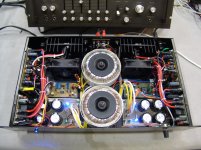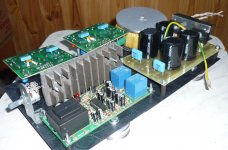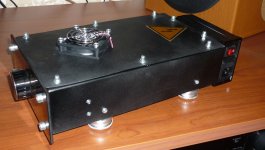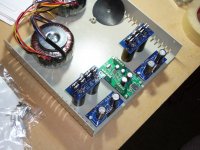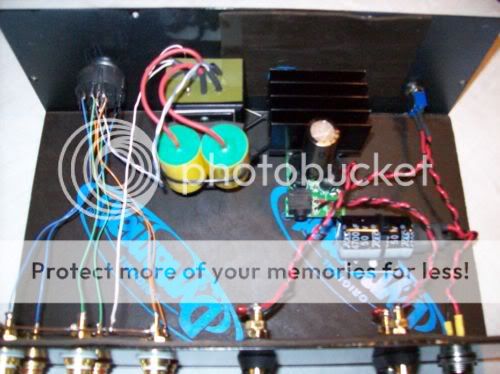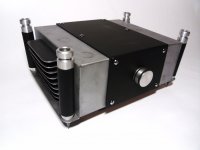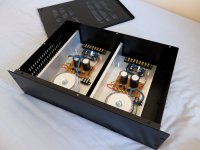bdos: that rca cable line-in goes RIGHT NEXT to the trafo!
that has to be causing hum. it has to be. I would not route it that way if I were you.
Transformer shielded input cable is shielded - no noise. This arrangement of the shortage of space... Thx for a critic ))
Transformer shielded input cable is shielded - no noise. This arrangement of the shortage of space... Thx for a critic ))
I used the same cable like yours with excellent results.
I use twisted pairs.
I have experimented routing line level twisted pair signal lines next to, on top off and around transformers and mains multi-ganged sockets. I cannot detect mains hum above the 0.1mVac level at the amplifier outputs. With my typical amp gains of 26dB to 31dB and speakers of 86dB to 92dB I have never heard the twisted pair strategy leading to audible hum at the speaker/s.
Hum is usually caused by a wiring error. Not by aerial pickup of a well laid out pair of line level signal and return pair.
I have experimented routing line level twisted pair signal lines next to, on top off and around transformers and mains multi-ganged sockets. I cannot detect mains hum above the 0.1mVac level at the amplifier outputs. With my typical amp gains of 26dB to 31dB and speakers of 86dB to 92dB I have never heard the twisted pair strategy leading to audible hum at the speaker/s.
Hum is usually caused by a wiring error. Not by aerial pickup of a well laid out pair of line level signal and return pair.
Last edited:
I don't want to 'chatter' too much in a photo thread (lol) but I've seen my own direct experiences in many amps where placement of trafo MUST be inches and even feet away from input circuits. that includes wiring to inputs. when I make umbilical PSUs, you can pick them up and move them around in-operation and hear the hum come and go. proximity DOES matter. twisted pair helps but power does radiate and wires are nice antennas. shielding and twisting is a 'help' but you cannot fight distance.
my last chip amp was the same thing, I use a trafo box over an umb. cord and the location of the trafo absolutely does affect the audible hum level. goes from no hum to very loud hum. if that was 'wiring error' why would movement of the trafo change things?
its not 'wiring error'. it can be, but that's not the ONLY thing that induces hum. you know that, come on!
my last chip amp was the same thing, I use a trafo box over an umb. cord and the location of the trafo absolutely does affect the audible hum level. goes from no hum to very loud hum. if that was 'wiring error' why would movement of the trafo change things?
its not 'wiring error'. it can be, but that's not the ONLY thing that induces hum. you know that, come on!
actually, it can be masked by various sensitivities.
one amp I had (behringer a500) sounded fine on my maggies. any hum was masked by the spkr lack of sensitivity. I changed those spkrs out and put efficient monitors in and the hum was there; had been all along but I didn't notice it until the spkr change.
all I'm saying is that it is likely there. maybe not heard now, but wiring that close to a huge trafo can't be good. its just not good wire placement and that's what I'm trying to get across.
chassis should be laid out with wiring in mind. I dont' see that enough, to be honest. that's what sparked my comment, I guess. lots of diy projects seem to consider wire placement as the last thing and I think that's the wrong way to go about it.
one amp I had (behringer a500) sounded fine on my maggies. any hum was masked by the spkr lack of sensitivity. I changed those spkrs out and put efficient monitors in and the hum was there; had been all along but I didn't notice it until the spkr change.
all I'm saying is that it is likely there. maybe not heard now, but wiring that close to a huge trafo can't be good. its just not good wire placement and that's what I'm trying to get across.
chassis should be laid out with wiring in mind. I dont' see that enough, to be honest. that's what sparked my comment, I guess. lots of diy projects seem to consider wire placement as the last thing and I think that's the wrong way to go about it.
Last edited:
Of course it is better to keep the wires further away from the transformer. On the other hand electromagnetic fields loose their power by the square of the distance and especially toroid transformers have only very narrow fields around them. A few mm of distance are usually enough.
It also helps to have the fields at right angles to each other as shown in posts 2035 and 2041. Hum is rather a question of grounding than of inductive coupling.
It also helps to have the fields at right angles to each other as shown in posts 2035 and 2041. Hum is rather a question of grounding than of inductive coupling.
Lucky for me, even keeping the E type transformers near my LM4780 based 5.1 setup also didn't produce any audible hum at speaker end. Even no On-off thumps.
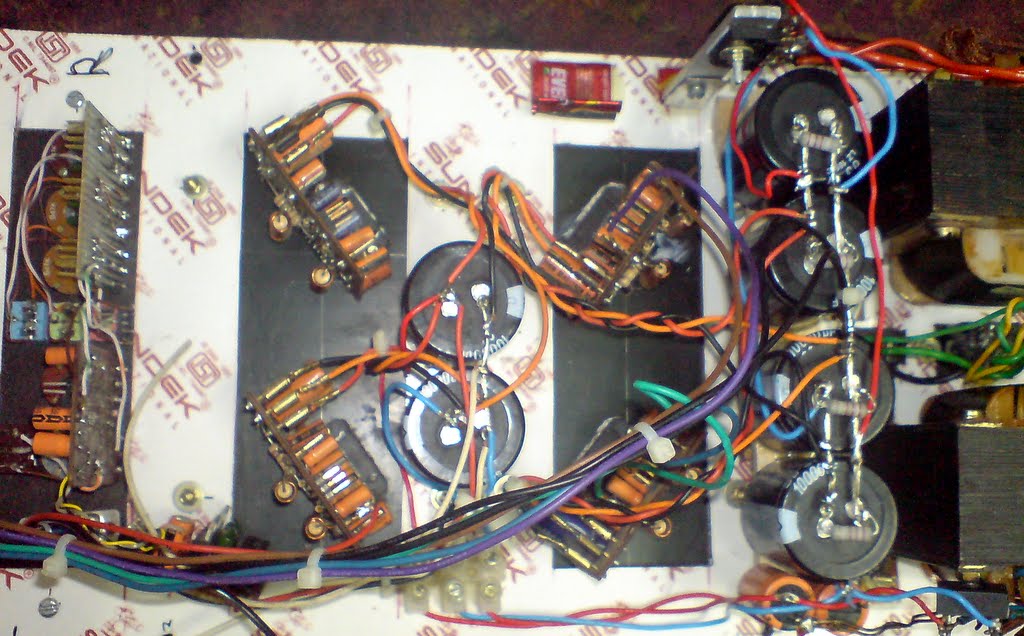
And i agree both with linuxworks and pacificblue, good grounding do keep the hum away as well. But a 22 gain amplifier with sensitive speakers may tend to transport transformer hum at output.
( But i didn't have those sensitive speakers also , lollz)
, lollz)
And i agree both with linuxworks and pacificblue, good grounding do keep the hum away as well. But a 22 gain amplifier with sensitive speakers may tend to transport transformer hum at output.
( But i didn't have those sensitive speakers also
Last edited:
I fail to comprehend why you should be so surprised. Whilst I wouldn't for a moment consider keeping the current wiring for 'production' use, nor let anybody other than myself near it, it's a solid connection that wouldn't come lose short of pulling hard enough to snap the wire. I can't see how anything could have gone wrong unless I purposefully started tugging at wires & putting my fingers where I know they shouldn't be put & if that were the case I wouldn't let myself near a 9V battery let alone 240V AC.
Considering the fact that the wiring in your house is not much different, I don't see a problem. It's fine for testing in my opinion. You don't even need to use a 3 prong plug. Many commercial amplifiers don't use those. Using a ring connector is neater and more reliable but shrink tubing is not required and doesn't make it safer.
I was originally going to have these LM3886 monoblocks separate, one sat on each speaker, but with the decision to build new speakers that plan would no longer work so I decided to box them up. 'Quick, cheap & simple' has turned into 'slow, expensive & stupendously overbuilt'. For scale, that's a 3U enclosure... Still, once I've set this all up hopefully I won't have any more complaints about safety 
I'm going to have this enclosure on end for a while (limited space in my current room) & I want to 'glue' the filter capacitors to the stripboard before I do, because atm they are only held on by their solder connections. What is the best material for this? Silicone sealant? I assume hot glue is a bad idea because it will damage the caps?
I'm going to have this enclosure on end for a while (limited space in my current room) & I want to 'glue' the filter capacitors to the stripboard before I do, because atm they are only held on by their solder connections. What is the best material for this? Silicone sealant? I assume hot glue is a bad idea because it will damage the caps?
Attachments
Last edited:
- Home
- Amplifiers
- Chip Amps
- Chip Amp Photo Gallery
